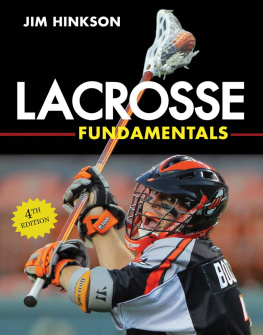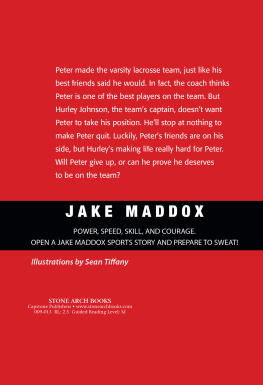David Urick - Lacrosse: Fundamentals for Winning
Here you can read online David Urick - Lacrosse: Fundamentals for Winning full text of the book (entire story) in english for free. Download pdf and epub, get meaning, cover and reviews about this ebook. year: 1988, publisher: Sports Illustrated, genre: Children. Description of the work, (preface) as well as reviews are available. Best literature library LitArk.com created for fans of good reading and offers a wide selection of genres:
Romance novel
Science fiction
Adventure
Detective
Science
History
Home and family
Prose
Art
Politics
Computer
Non-fiction
Religion
Business
Children
Humor
Choose a favorite category and find really read worthwhile books. Enjoy immersion in the world of imagination, feel the emotions of the characters or learn something new for yourself, make an fascinating discovery.

- Book:Lacrosse: Fundamentals for Winning
- Author:
- Publisher:Sports Illustrated
- Genre:
- Year:1988
- Rating:3 / 5
- Favourites:Add to favourites
- Your mark:
- 60
- 1
- 2
- 3
- 4
- 5
Lacrosse: Fundamentals for Winning: summary, description and annotation
We offer to read an annotation, description, summary or preface (depends on what the author of the book "Lacrosse: Fundamentals for Winning" wrote himself). If you haven't found the necessary information about the book — write in the comments, we will try to find it.
Eight-time national championship coach David Urick shows players and coaches the pathways to lacrosse success!
Lacrosse: Fundamentals for Winning — read online for free the complete book (whole text) full work
Below is the text of the book, divided by pages. System saving the place of the last page read, allows you to conveniently read the book "Lacrosse: Fundamentals for Winning" online for free, without having to search again every time where you left off. Put a bookmark, and you can go to the page where you finished reading at any time.
Font size:
Interval:
Bookmark:

LACROSSE
Fundamentals for Winning
BOOKS ON TEAM SPORTS
Baseball
Football: Winning Defense
Football: Winning Offense
Hockey
Lacrosse
Pitching
BOOKS ON INDIVIDUAL SPORTS
Bowling
Competitive Swimming
Golf
Racquetball
Skiing
Tennis
Track: Championship Running
SPECIAL BOOKS
Canoeing
Fly Fishing
Scuba Diving
Strength Training

To Jerry Schmidt, former lacrosse coach at Hobart College, for a willingness to share not only his great knowledge of the game but also his wonderful approach to people.
To Hobart assistant coaches Tom Korn, Terry Corcoran, Hank Janczyk, B.J. OHara, Pete Gillotte, Jack McDonald, and Mark VanArsdale, from whom I have learned and continue to learn so much.
To Hobart College lacrosse players, past and present, for their approach to the gameintense, proud, yet fun.
To Mrs. Dorothy DeBacco for being a fine secretary and able to read my handwriting.
To Bill Jaspersohn, editor, Sports Illustrated Winners Circle Books, for his patience, encouragement, and expertiseparticularly his patience.
To Linda Urick, for being my typist, proofreader, critic, advisor, and, most important, my best friend.
To Holly, Scott, and Mindy, for always giving their dad a good reason to smile.
And an extra-special thanks to Mom, Dad, and Linda.
Picture credits: by Art Foxall; 10 courtesy of the Lacrosse Hall of Fame Archives; 32 by Bill Jaspersohn; 234 by Jan Regan; 26, 29, 37 (right), 50, 93, 166, 178, 220, 232, 250 by Jack Phillips. All diagrams by Frank Ronan. All other photographs by Heinz Kluetmeier.
SPORTS ILLUSTRATED LACROSSE: FUNDAMENTALS FOR WINNING. Copyright 1988 by Time Inc. All rights reserved. Printed in the United States of America. No part of this book may be used or reproduced in any manner whatsoever without written permission except in the case of brief quotations embodied in critical articles and reviews. For information address Sports Illustrated Winners Circle Books, Time & Life Building, 1271 Avenue of the Americas, New York, N.Y. 10020.
FIRST EDITION
Designer: Kim Llewellyn
Library of Congress Cataloging-in-Publication Data
Urick, David.
Sports illustrated lacrosse / by David Urick; photography by Heinz Kluetmeier.
p. cm.
1. Lacrosse. I. Kluetmeier, Heinz. II. Sports illustrated (Time, inc.) III. Title. IV. Title: Lacrosse.
GV989.U75 1988
796.347dc19
87-36462
ISBN 978-1-56800-071-8

LACROSSE
Fundamentals for Winning

Originated long ago by North American Indian tribes, baggataway was the forerunner of modern lacrosse.
Some years ago, the famed sportswriter, Grantland Rice, wrote of lacrosse:
Once in a while they argue about the fastest gamehockey or basketball; then about the roughest gameboxing, football, or water polo. But when it comes to the top combination the answer is lacrosse, the all star combination of speed and body contact. It requires more elements of skill than any game I know.
The sport of lacrosse, the oldest-known athletic game played in North America, was originally not a sport at all. Called baggataway by the North American Indian tribes that founded and played it long before Columbus discovered the New World, lacrosse originated as a ceremonial religious rite. Virtually all tribes of southern Canada and the United States, except those in the Southwest, played some type of lacrosse, and games were usually preceded by solemn rituals and dances.
White settlers in the early 17th century gave lacrosse its European name. French Jesuit missionaries felt that the stick used in the contest resembled the type of staff, or crosier, carried by their bishops and known, in French, as la crosse. From then on, baggataway went by the name lacrosse.
The original equipment used by Indian tribes was quite simple. The lacrosse stick was a wooden shaft, curved at the top, with leather netting woven into the curved section and used for catching and throwing a ball. Materials used for balls included rocks wrapped in animal skins; carved, rounded pieces of wood, or other available round items. The strategy of each player, originally, was to incapacitate as many opponents as possible with his lacrosse stick and then try to score a goal.
Intertribal games of lacrosse were played for many different reasons. Disputes between tribes were often settled on the outcome of a single match, and the sport was used as a means of training young warriors for battle.
The games themselves could vary from contest to contest. Some were highly structured, with only five to six players to a side, and boundaries clearly defined. Others could involve nearly a thousand players, with tribal villages serving as field boundaries and play lasting for days. Injuries and even deaths were not uncommon during these mass contests. Not surprisingly, the word baggataway literally means the little brother of war.
Lacrosse as we know it today began to be played around 1840, in eastern Canada, near Quebec and Montreal. So popular was the sport that, in 1867, the Canadian Parliament declared it Canadas national game. Today, lacrosse is played on an organized basis in England, Canada, Australia, Wales, Scotland, France, Belgium, Japan, Italy, Czechoslovakia, and the United States.
Many modern lacrosse purists argue that lacrosse is the oldest and fastest sport on two feet. Whether or not their claim is true, one thing is certain: Lacrosse as its played nowadays is good, clean, hard, and skill-intensive fun.
In the U.S. today, lacrosse is played and enjoyed by men and women, boys and girls, young and not so young, from coast to coast. The experienced lacrosse player can play the sport long after high school and college via club leagues, summer leagues, and even organized indoor competition, while the young player, who, in most cases, develops his skills with the aid of a friendly wall, can participate in youth lacrosse leagues, which, in the past 15 years, have cropped up in every region of the country.
In between these youth and adult levels are highly organized and keenly competitive interscholastic and intercollegiate lacrosse leagues. Over the past 30 years, these have spread throughout the country, and the advent of the National Collegiate Athletic Association (NCAA) Lacrosse Championships, in 1971, have further assisted the growth of the sport at this level.
What, exactly, is lacrosses big appeal?
Lacrosse, as it is played today, is unique to American athletics, yet it combines many of the best elements of other popular sports. For example, the physical demands of lacrosse are remarkably similar to those required for football, while its individual and defensive team concepts somewhat parallel those of basketball. The free-flowing nature of the game, from offense to defense, over the vast expanse of a large field (allowing spectators to enjoy all of the sports subtleties), closely resembles soccer. And the speed of ball movement and the ability of teams to attack from, and defend the area behind the goal, echoes the play in hockey.
Next pageFont size:
Interval:
Bookmark:
Similar books «Lacrosse: Fundamentals for Winning»
Look at similar books to Lacrosse: Fundamentals for Winning. We have selected literature similar in name and meaning in the hope of providing readers with more options to find new, interesting, not yet read works.
Discussion, reviews of the book Lacrosse: Fundamentals for Winning and just readers' own opinions. Leave your comments, write what you think about the work, its meaning or the main characters. Specify what exactly you liked and what you didn't like, and why you think so.








